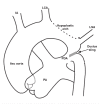The challenge in diagnosing coarctation of the aorta
- PMID: 29293259
- PMCID: PMC6421548
- DOI: 10.5830/CVJA-2017-053
The challenge in diagnosing coarctation of the aorta
Abstract
Critical coarctation of the aorta in neonates is a common cause of shock and death. It may be the most difficult of all forms of critical congenital heart disease to diagnose because the obstruction from the coarctation does not appear until several days after birth (and after discharge from the hospital), and because there are no characteristic murmurs. Some of these patients may be detected by neonatal screening by pulse oximetry, but only a minority is so diagnosed. Older patients are usually asymptomatic but, although clinical diagnosis is easy, they are frequently undiagnosed.
Figures


References
-
- Hoffman JIE, Kaplan S. The incidence of congenital heart disease. J Am Coll Cardiol. 2002;39:1890–1900. - PubMed
-
- Wren C. The Epidemiology of cardiovascular malformations. In: Moller JH, Hoffman JIE, Benson DW, van Hare GF, Wren C (eds). Pediatric Cardiovascular Medicine. Oxford, England: Wiley-Blackwell, 2012. :268–275.
-
- Crichton CA, Smith GC, Smith GL. Alpha-toxin-permeabilised rabbit fetal ductus arteriosus is more sensitive to Ca2+ than aorta or main pulmonary artery. Cardiovasc Res. 1997;33:223–229. - PubMed
-
- Clyman RI. Mechanisms regulating the ductus arteriosus. Biol Neonate. 2006;89:330–335. - PubMed
-
- Coceani F, Wright J, Breen C. Ductus arteriosus: involvement of a sarcolemmal cytochrome P-450 in O2 constriction? Can J Physiol Pharmacol. 1989;67:1448–1450. - PubMed
Publication types
MeSH terms
LinkOut - more resources
Full Text Sources
Other Literature Sources
Medical

